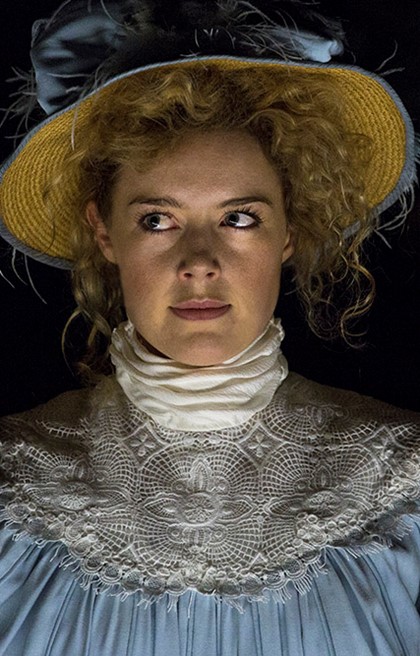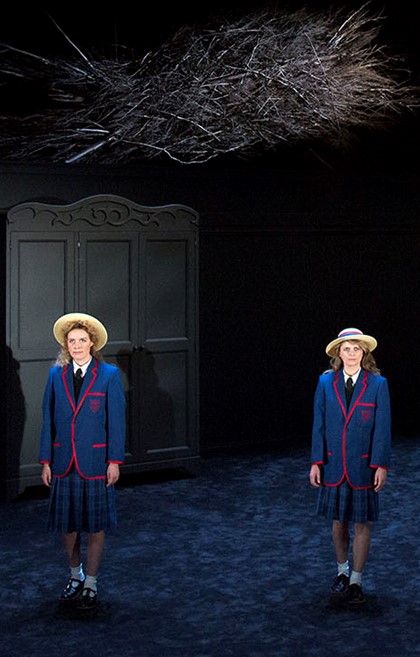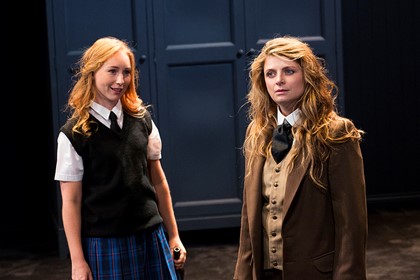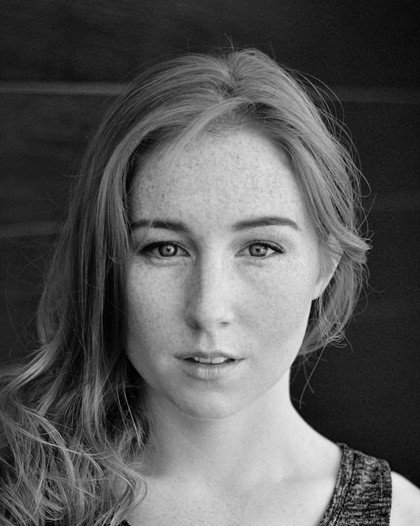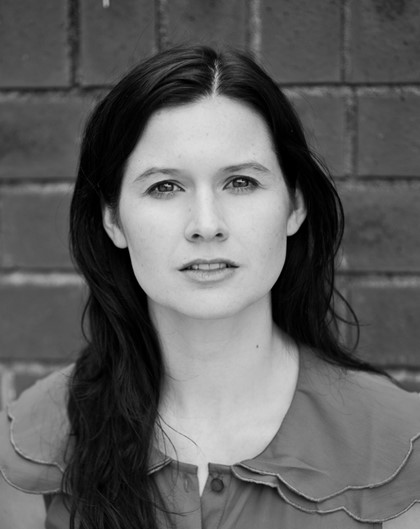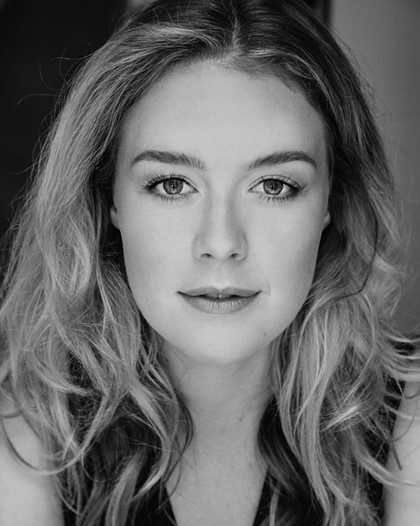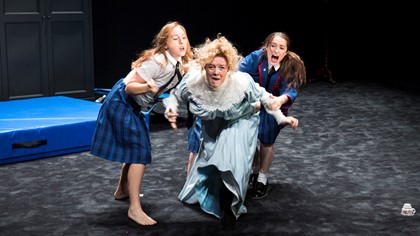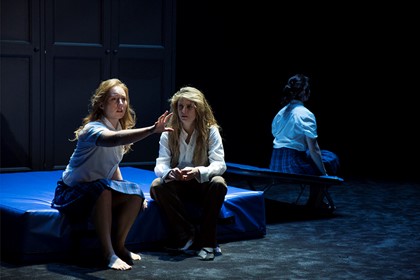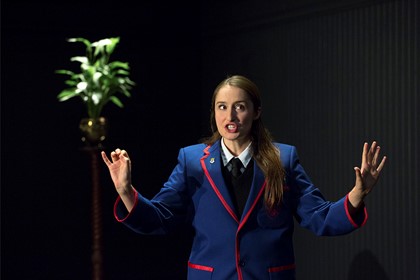Matthew Lutton’s haunting production of Picnic at Hanging Rock had audiences screaming in their seats. Drawing on the extensive commentary and conversation that swirls around the novel and this production, Rob Reid speaks to what this story reveals about our national obsessions, and what it obscures.
First published in 1967, Picnic at Hanging Rock by Joan Lindsay is an icon of Australian literature. Set in 1900, the novel tells a story of the disappearance of a group of boarding schoolgirls lost in the bushlands surrounding Macedon in Victoria, that is still so resonant with contemporary the Australian experience that even today many people are surprised to discover that this work of fiction was not based on real events. Lindsay’s novel was further lifted into Australian folklore by the lauded 1975 film adaptation by director Peter Weir, which takes the Gothic elements of Lindsay’s work and uses them to showcase the Australian landscape through a more Romantic lens, famously draping a bridal veil over the camera for much of the filming to achieve a hazy, dream like quality to the footage.
Before being made famous by the novel and film however, the archeological formation known by its Westernised name, Hanging Rock, was a significant site for the traditional owners of the land, marking the boundaries between the territories of several different First Nations groups: the Woi Wurrung (Wurundjeri), Dja Dja Wurrung and Taungurung. Malthouse Producer, Jason Tamiru, a Yorta Yorta and Dja Dja Wurrung man of the Yung Balug Mob, wrote a blog post presenting the Yung Balug perspective on the rock, explaining:
'At first, I refrained from naming the Rock due to the reality of seeing it listed differently in a number of different places. After speaking to family, the rightful name of Hanging Rock is Ngannelong. Picnic at Ngannelong.
The truth is my people were hit hard during the frontier wars. The Western region is known to us as the Killing Fields. The naming of the Rock is with all those that come in my dreams. Australia is starting to learn that there is a black history in this country that needs to be acknowledged and celebrated.
Long before the 1967 novel, 1975 film and the naming of Hanging Rock, Tribes of the Dja Dja Wurrung, Woi Wurrung and Taungurung would gather at that location for important Men’s Ceremony. This is a place where big business was held: Corrobborees, Initiation Ceremonies, Songline Ceremonies, trade and relationship building and a place where laws were made and passed. The mystique and spiritual essence of the rock has contributed to the story of our Dreaming which binds my people to our creator spirits and country. We Sing, Dance and Paint our Country forever.'ᶦ
Lindsay’s novel largely takes place in both the bushland on and around the landmark Victorian geological formation Hanging Rock, the remains of a former volcano, and in the fictional Girls Grammar school, Appleyard College, which was to some extent based on Lindsay’s own Grammar school experience at Clyde Girls Grammar School in East St. Kilda, Melbourne. The contrast between the Australian rural landscape and the English educated schoolgirls has been much commented on by critics and academics drawing the connection between Lindsay’s atmospheric horror story and the colonizing settler experience of Australian history. Though this is clearly a strong current in the story, both Lindsay’s novel and Weir’s film achieve a complexity and depth beyond the purely postcolonial reading by hinting at elements of mysticism, queer identity and lesbian relationships and their repression, and burgeoning feminism in the 1900s. Never completely explicit in the telling, Picnic at Hanging Rock remains a mystery to be unpacked in a multitude of ways, almost stubbornly non-didactic in its vagaries.
For this reason, and of course for its canonical place in Australian culture, Picnic at Hanging Rock has been the subject of several stage and television adaptations as well as Weir’s famous film. The Therry Dramatic Society produced a stage adaptation of Weir’s script for the Adelaide Fringe festival in 1994, The Oz People presented Picnic at Hanging Rock: The Solution at Queensland’s Twelfth Night Theatre, also in 1994, and Canberra based Free-Rain Community theatre produced an adaptation of the film at the Courtyard Studio in 2008. A six-episode made-for-television adaptation of the novel was produced for Foxtel in 2018.
Artistic Director, Matthew Lutton, became interested in the story when reading the novel during rehearsals for Patrick White’s A Night on Bald Mountain in 2014. Lutton told an interviewer that 'it was written about the same time, they both engaged with similar ideas about landscape, so that’s where the idea for this project happened.'ᶦᶦ Lutton’s work as a director is known for its hallmarks of dark and sometimes shocking aesthetics alongside a fascination with the deeper social and philosophical themes of such work. Originally from Perth, Lutton told an interview on his return to the state for the tour of Picnic at Hanging Rock, 'People seem to remember all my shows in Perth having blood and gore. There is no blood in this show, but it certainly follows the trajectory of having darker qualities. A whole bunch of ideas I was exploring in Perth are still very present in the work that I create, but I hope people see this as a maturing of ideas.'ᶦᶦᶦ
The text adapted for the stage from the novel by Tom Wright and premiered at The Merlyn in 2016, a co-production with Black Swan State Theatre Company. Wright and Lutton took a meta-theatrical approach to the interpretation, utilizing five actors to play all seventeen roles in the story as well as providing meta-commentary on the story as versions of themselves. The actors are dressed in 21st Century school uniforms, anchoring the retelling through the eyes of a new generation.
Each actor played multiple roles and switched between them with a fluidity that was widely praised by critics. Jo McEniery said in ArtsHub that 'The acting in this adaptation is superb, and the cast expertly guides its audience into a lingering sense of unease and dread,'ᶦᵛ and Kimberley Shaw in Stage Whispers praised each actor at length, saying, 'The performers are, without exception, excellent. All convincingly play schoolgirls in the opening sequence and at varying times. Recent WAAPA graduate Harriet Gordon Anderson gives elegance and poise to Mademoiselle and a rough-diamond larrikin charm to Albert, local actress Arielle Gray portrays the fragile Sara and frightened Edith with vulnerability yet power, Amber McMahon gives gentlemanly charge to Michael, Nikki Sheils is lovely as the tortured Irma and Elizabeth Nabben plays the formidable Mrs. Appleyard with great depth.'ᵛ
Lutton told the West Australian that 'Our casting wasn’t about finding actors who would match specific roles… the actors are more like ciphers rather than individual characters, they’re almost channeling, or possessed by the voices of the story they are telling. We wanted five figures that were like a Joan Lindsay chorus—holders of the myth. It was an interesting task to find five actors who could work as an ensemble but also retrain distinct and separate voices.'ᵛᶦ
Lutton’s production largely focused on the existential horror baked into Lindsay’s novel, foregoing the atmospheric nostalgia of the Weir film. Tim Byrne described Lutton and Wrights approach to the text, writing: 'Wright’s soaring lyricism matches Lindsay’s precise and evocative prose. The tone is, if anything, more intensely creepy and lush. Mathew Lutton keeps such a tight rein on the production elements that there is little time to breathe. Blackouts so sudden and absolute they feel like plunges into the abyss, and several wordless vignettes – the girls ominously moving toward a great void, or haunting miming schoolyard games – are almost unbearably sinister…. The sense that time is running out of control, the hands of the clock leaping indiscriminate around the dial, fits perfectly with the novel’s preoccupations.'ᵛᶦᶦ
Maxim Boom writes for Limelight magazine: 'Fear is a relatively rare reaction provoked by live theatre, but Lutton’s aptitude for raising the adrenaline and widening the eyes is impressive. As we drift further into this hallucination, the bodies on stage become mangled and contorted, their odd angles and crumpled limbs further adding to the sense of unnerving strangeness. Even the theatre is chilled to an almost uncomfortable level of cold.'ᵛᶦᶦᶦ
Of the horror elements of the production, Lutton said 'You don’t often see horror on stage, it’s not a common form in theatre, but it does go back to things like telling ghost stories. You do think about how we scare people when we’re telling stories in the dark, it's often about the way it’s primed, the set up and the mood. You don’t have to show people much to scare them, it’s something Hollywood worked out years ago, don’t show too much… Theatre can do that well, but it’s the same with the decision not to put the rock on stage – is it better to get the audience to use their imagination.'ᶦˣ It was clearly effective, as Actor Arielle Gray said of performing in the production, 'There’s one particular moment in the show that I absolutely love which really scares the crap out of people. I’m in a position on stage where I can see the audience in the next scene. It’s so gratifying, because there are people just wriggling in their seats, they’ve been so physically affected by the show.'ˣ
As with the novel and the film, a great deal of the critical commentary on the Malthouse production focused on the postcolonial aspects of the story. Some critics drew attention to the tale’s obvious reflection of the postcolonial trope of the ‘out of place' coloniser in unfamiliar and threatening territory that is present in both the book and the production, and sometimes bemoaning the loss of the sweeping vistas of Australian landscapes familiar from the film.
Pip Christmas writes that Picnic at Hanging Rock 'has captured the Australian imagination for decades, with its powerful sense of foreboding and its incisive take on the colonial experience of the outback as something to be feared, something which needs to be ‘tamed.’'ˣᶦ Boom notes that the schoolgirls '…pale white skin, ankle length petticoats and 19th century deportment are seemingly consumed by the wild, untamed crags and jagged recesses of the Australian wilderness.' He concludes that '… without the epic drama of the Australian landscape to power a sense of vulnerability and awe, this script has had to provide a substantial amount of scene setting.'ˣᶦᶦ McEniery writes, 'Much of the draw of the original novel and film adaptation is in the depiction of nature—the wild Australian bush landscape—as all-consuming and an entity in itself. The lack of visual reference to the landscape that is such an integral aspect of this work is disappointing and seems an obvious oversight.'ˣᶦᶦᶦ
Curiously, while this commentary is aware of the implications of the postcolonial tropes, it also reiterates and entrenches those same tropes without much critical engagement. Ashcroft, Griffiths and Tiffin identified this fetishization and othering of the colonised landscape, explaining that 'In the case of settler countries (like Australia) … land was occupied by European colonists who dispossessed and overwhelmed the Indigenous populations. They established a transplanted civilization which eventually secured political independence while retaining a non-indigenous language. Having no ancestral contact with the land, they dealt with their sense of displacement by unquestioningly clinging to a belief in the adequacy of the imported language—where mistranslation could not be over-looked it was the land or the season which was ‘wrong.'ˣᶦᵛ The girls in Lindsay’s novel, Weir’s film and—it has to be said—Lutton and Wright’s production, are equal parts the postcolonial trope of the Lost Child and an example of Missing White Woman Syndrome.
Jay Daniel Thompson, reflecting on the trope of the lost child, recounts the many times it has played out in Australian literature and history, including 'novels such as Suzanne McCourt’s The Lost Child …(and) the many real-life lost child cases. The best-known Australian lost children are the Beaumont siblings, who disappeared from Glenelg Beach in 1966, apparently into thin air, and Azaria Chamberlain, who went missing in Central Australia in 1980, and was the subject of John Bryson’s Evil Angels (1988), and the Hollywood film.'ˣᵛ
Given the regular reappearance of this trope in literature and news media, it’s easy to see how people can simply accept that Lindsay’s novel, with its mixture of reportage and rumour, might be based on a true story. However, this trope reflects the anxiety of the coloniser in an unfamiliar environment, shifting responsibility for their own fear and confusion onto the seasons, wildlife and civilisations of the colonised land, as easily as they can be seen as anxiety over lost innocence. Thompson, again, writes, 'In Western culture, childhood has commonly been associated with 'innocence'. So, too, has that mythical world we call ‘the past’,'ˣᵛᶦ and it’s this loss of innocence, particularly white innocence, which reflects the increasing inability for contemporary. Australia to remain insulated from complicity in its colonial past. As Byrne writes in his review, Picnic at Hanging Rock 'repositions what poet Mary Fullerton called ‘the rude and ruthless bush’ as a mirror to a white Australia that barely acknowledges its own monstrosity. It shows how otherness can unravel the carefully articulated façade that mainstream Australia has erected as a bulwark against our own dark past. The need to retell this story, to constantly return to the rock and see what else we may find there, gives this adaptation an immediacy, even an contemporaneity, that is hard to resist.'ˣᵛᶦᶦ
These deeper concerns, from a postcolonial standpoint, are surely less to do with the displaced English educated schoolgirls and the lost innocence they represent, and more to do with white washing of the actual history of the story’s setting, where historical massacres of the indigenous population took place during colonisation, and the erasure of the physical site’s significance to three different First Nations groups. Here, in Picnic at Hanging Rock and the cultural adoption of it as part of Australian mythology, we can see the effect of the Missing White Women Syndrome, the term used by social scientists and in media commentary to describe the disproportionate focus on reporting and retelling missing persons cases featuring young, white, middle class or wealthy women compared with a corresponding lack of attention given to the disappearance of women and children of colour.
It’s also significant that only a few reviewers note the elision or excision of the queer and homoerotic elements of Lindsay’s story. One of those few, Van Badham, puts it succinctly in the Guardian: 'Only passing mention is made of Sara’s explicit infatuation with Miranda, a lesbian visibility that other adaptations make clear, is what provokes Mrs. Appleyard’s savagery towards Sara as a means of denying her own inclinations. As a result, in the Malthouse production the powerful sexual motives that underlie Mrs. Appleyard’s torture of Sara are replaced as repeated scenes of uppity bullying. It’s a shame, for exorcising the sexual energy from the characters denies potential for a more palpable experience of an already disturbing tale. Horror is of the body, after all…'ˣᵛᶦᶦᶦ
Lutton says 'I think the story persists in the Australian psyche because we can all identify with the idea of how the landscape can terrify us… it can be beautiful and inspiring, but it can also obliterate us. That’s very Australian, I think. Lindsay was also continually unpacking the idea of the colonial and the postcolonial experience of Australia, which is something we’re still trying to resolve now: what it means to be a 'foreigner' in this land. I also think that theme of disappearance, the unfinished nature of the story, continues to intrigue us.'ˣᶦˣ
Costanza Bergo explains how the postcolonial landscape persists in the mind of the colonisers, saying 'Settler colonial landscape is increasingly understood as a spatial project produced by imagined geographies. This fantasy-scape is a separate entity from physical, occupied landscape; yet it always maintains a relation to it and can manifest spatially. Settler colonialism operates as a structure that must be continuously performed, asserted, and naturalised. Part of what allows this structure to be naturalised is a network of affective registers: a structure of feelings.' Bergo goes on to say of the impact Picnic at Hanging Rock has had on that landscape, '…While the story is entirely fictional, the movie’s lasting legacy has sparked real-life search parties and a large body of historical research in which the goal is to find the imaginary missing girls. By contrast, the history of Indigenous massacres in the same area have been entirely overlooked.'ˣˣ
Lindsay’s original novel is one marked by and centered around absences. They echo throughout the text in many more ways than one. The absence of Aboriginal culture erased by English colonisation and settlers; the absence of queer adolescence hushed and punished away into silence by proprietorial, religious and patriarchal suppression; the absence of a decisive conclusion to the original novel (assuming we ignore the 'final' chapter released in 1987, three years after Lindsay’s death and originally excised before publication). Into these absences the settler community can empty it’s conscious anxieties, whatever they may be during whatever time, instead of unearthing the more willfully unconscious anxieties of the coloniser, the guilt and shame of colonisation and the brutal truth of its massacres and genocides.
Dr. Diana Sandars, explains that 'the settler anxieties that underlie this folklore, omit the colonial history of the Stolen Generations – the stories of thousands of Indigenous children, lost to their communities. The cultural fascination with Joan Lindsay’s novel has extended this historical rewriting to the Indigenous history of the Macedon region—substituting the pseudo-history of the novel for the lived history of the Indigenous communities there.'ˣˣᶦ Or, as Jacqueline Bublitz put it in her review of the production, '…What we are willing to believe says more about ourselves than the story being told, don’t you think?'ˣˣᶦᶦ
The horror of the schoolgirls lost on the rock is the mere reflection on the surface of this seemingly serene and picaresque mystery. The real mysteries are the tumultuous depths in which swirl dark and powerful currents of displacement, erasure, colonisation, sexual repression, and homophobia – each as much part of the myth of Australia as the beautiful and deadly landscapes and the iconic pan pipes of nostalgia.
Picnic at Hanging Rock premiered on the Merlyn stage in 2016, toured to the Heath Ledger Theatre in Perth, then to the Royal Lyceum Theatre in Edinburgh. It returned to the Merlyn in 2018 before touring to the Barbican in London.
Dr. Robert Reid is an independent playwright, theatre historian, immersive performance designer and critic. They were the artistic director of independent theatre company Theatre in Decay and immersive performance and game company, Pop Up Playground. Dr . Rob's plays have been performed by the MTC and Black Swan, and their immersive works have been presented by the MSO, SLV, City of Melbourne, Bell Shakespeare and the Melbourne Football Club. Dr. Rob has a PhD in Australian Theatre History, was a co-founder and co-editor of WitnessPerformance.com and now runs the YouTube channel, Television is Furniture presenting reviews, history and analysis of contemporary Australian theatre.
Citations & References
ᶦ Tamiru, Jason. “Producer Jason Tamiru Shares the Yung Balug Perspective of Hanging Rock”, Malthouse Theatre Engine Room blog website, Feb 02, 2018.
URL: https://www.malthousetheatre.com.au/engine-room-blog/jason-tamiru-the-yung-balug-perspective-of-hanging-rock/
ᶦᶦ Hill, Leigh. ‘Stage Fright with ‘Picnic at Hanging Rock’ director Mathew Lutton”, Out in Perth, 24 March 2016
ᶦᶦᶦ Taylor, Belle. ‘Curtains open on picnic at Hanging rock’, PerthNow, 29 March 2016
ᶦᵛ McEniery, Jo. ‘Picnic at Hanging Rock’, ArtsHub, 7 march 2016
ᵛ Shaw, Kimberley. ‘Picnic at hanging rock’, Stage Whispers, 18 May 2016
ᵛᶦ Christmass, Pip. ‘Lutton sets stage for bush picnic”, The West Australian, 15 March 2016
ᵛᶦᶦ Byrne, Tim. ‘Picnic at Hanging Rock (Malthouse Theatre)’, Arts Update, 4 March 2016
ᵛᶦᶦᶦ Boom, Maxim. ‘Review: Picnic at Hanging Rock (Malthouse Theatre)’,Limelight Magazine, 4 March 2016
ᶦˣ Hill, Leigh. Op. Cit.
ˣ Binford, Cicely, ‘They’ve been so physically affected by the show’, Xpress Magazine, 30 March 2016
ˣᶦ Christmass, Pip. Op. Cit.
ˣᶦᶦ Boom, Maxim. Op. Cit.
ˣᶦᶦᶦ McEniery, Jo. Op. Cit.
ˣᶦᵛ Ashcroft, Bill, Griffiths, Gareth and Tiffin, Helen. The Empire Writes Back. Routledge. Milton park, Abingdon, Pg 8
ˣᵛ Thompson, Jay Daniel. ‘The ‘lost child’ is a white Australian anxiety about innocence’, The Conversation, 18 November 2014
ˣᵛᶦ Ibid
ˣᵛᶦᶦ Byrne, Op. Cit
18 Badham, Van. ‘Picnic at Hanging Rock review – vanishing schoolgirls haunt a new generation’, The Guardian, 3 March 2016
ˣᶦˣ Christmass, Pip. Op. Cit
ˣˣ Bergo, Costanza. ‘White vanishing and Settler Colonial Anxiety in the 1975 Film “Picnic at Hanging Rock”’, Visual and Material History, 22 December 2019.
URL: https://blogs.eui.eu/visual-material-history/white-vanishing-settler-colonial-anxiety-1975-film-picnic-hanging-rock/
ˣˣᶦ Sandars, Diana. ‘WHY THE LOST DAUGHTERS OF PICNIC AT HANGING ROCK STILL HAUNT US’, Pursuit, University of Melbourne, Humanities, 3 May 2018.
URL: https://pursuit.unimelb.edu.au/articles/why-the-lost-daughters-of-picnic-at-hanging-rock-still-haunt-us
ˣˣᶦᶦ Bublitz, Jacqueline. ‘BWW Review: Picnic at Handing Rock, Malthouse Theatre’, Broadway World, 4 March, 2016.
URL: https://www.broadwayworld.com/australia-melbourne/article/BWW-Review-PICNIC-AT-HANGING-ROCK-Malthouse-Theatre-20160304
